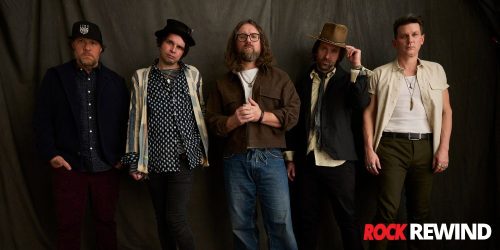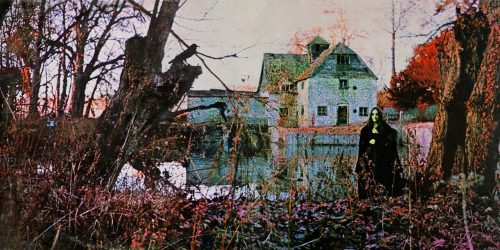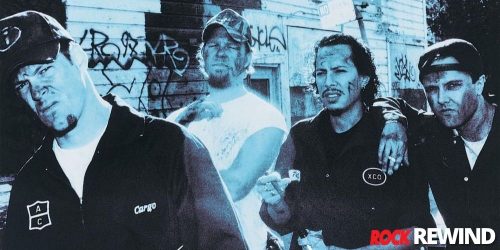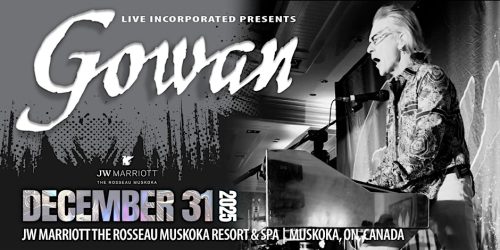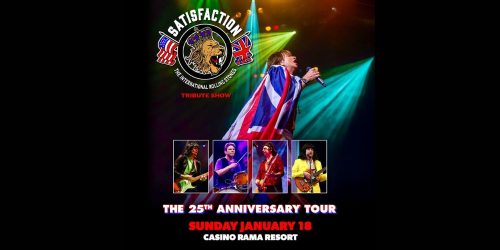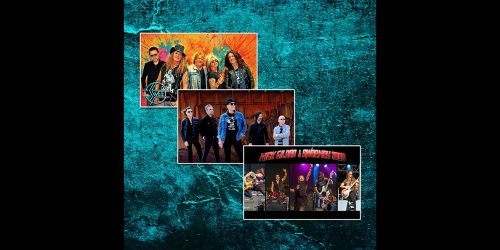ROCK REWIND: ELVIS PRESLEY HELPS BRING ROCK N ROLL MAINSTREAM
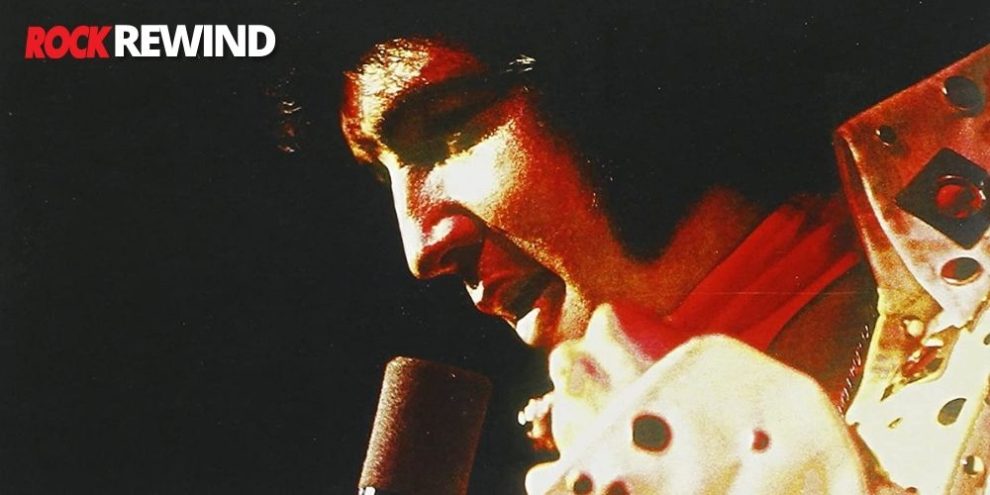
Elvis Aaron Presley was born January 8, 1935, in Tupelo, Mississippi 35 minutes after his still-born brother.
Touted as one of the most culturally significant people of the 20th century, Presley had a too short but incredibly successful career in rock.
He’s the best-selling solo artist of all time, has the most RIAA certificates ever, and has the most charted albums on Billboard 200. While he’s frequently called “The King of Rock n Roll”, he has covered many genres from gospel and rock to pop and country.
Let’s take a deeper look into his history …
Discovering His Love For Music
Elvis discovered his passion for music at church, which he attended regularly with his family.
In 1941 he started 1st grade at East Tupelo Consolidated. 4 years later, one of his teachers encouraged him to enter a singing contest, after hearing him sing “Old Shep” during morning prayers. He entered the Mississippi-Alabama Fair competition and placed fifth.
Receiving His First Guitar
On his 11th birthday, Elvis received his first guitar, though it wasn’t what he asked for. Still, he embraced the instrument and for the next year, he took guitar lessons with his uncles and the family’s pastor.
Presley once shared, "I took the guitar, and I watched people, and I learned to play a little bit. But I would never sing in public. I was very shy about it."
In 1947, he began bringing his guitar to school where he played and sang during his lunch break. Many regarded him as a loner and teased him for playing hillbilly music.
One of Presley’s classmates was the younger brother of Mississippi Slim, who had a show on the local radio station. Slim would regularly have Elvis come to the station where he taught him chord techniques.
In 1948, when Elvis was 13, the family relocated to Memphis, Tennessee. In 1950, Elvis began playing guitar more regularly and received lessons from Lee Denson, a neighbour who was only a couple of years older than Elvis.
Along with Dorsey and Johnny Burnette, Elvis and Denson formed a musical group. They often played around Lauderdale Courts. Slowly, Elvis began to creep out of his shyness. He began to stand out more at school with his flashy Lansky Brothers clothing, sideburns, and greased hairstyle.
In a biography written by Peter Guralnick, Elvis shares, “I wasn't popular in school ... I failed music – only thing I ever failed. And then they entered me in this talent show ... when I came onstage I heard people kind of rumbling and whispering and so forth, 'cause nobody knew I even sang. It was amazing how popular I became in school after that."
By graduation that same year, Elvis knew that music was his future …
Recording With Sam Phillips
In August 1953, Elvis cut his first acetate at Memphis Recording Service, owned by Sam Phillips. While he said he was there to record a gift for his mom, many believe he specifically chose the studio in hopes of being discovered.
While in the studio, Elvis covered “My Happiness” and “That’s When Your Heartaches Begin.” Marion Keisker was the receptionist the day Elvis came in. She says Phillips wasn’t at the office that day but remembered hearing her boss say he wanted “to find a white man who sounded Black.”
Keisker shares, “I wrote down on a little slip of paper, 'Elvis Presley, good ballad singer' and a telephone number he could reach, and I wrote 'save' on it and put it under my desk.” She later encouraged Phillips to record Elvis again.
Phillips recalls being in the studio and noticing Elvis’ arrival. He says he helped Elvis make his first record.
Sam Phillips Invites Elvis Back
Regardless of how the first day transpired, Elvis was invited back months later. During the visit, Phillips had Scotty Moore join Elvis on lead guitar and Bill Black on bass. By the time evening fell on their July 5 recording session, the trio had nothing. Suddenly Elvis picked up his guitar and started playing “That’s All Right (Mama)” by Arthur Crudup.
Moore recalls, "All of a sudden, Elvis just started singing this song, jumping around and acting the fool, and then Bill picked up his bass, and he started acting the fool, too, and I started playing with them. Sam, I think, had the door to the control booth open ... he stuck his head out and said, 'What are you doing?' And we said, 'We don't know.' 'Well, back up,' he said, 'try to find a place to start, and do it again.'"
On July 8, DJ Dewey Phillips aired the song on his show and suddenly everyone was wanting to know who the singer was. By July 17, the trio had their first gig at the Bon Air Club. And at the end of the month, they played Overton Park Shell where Elvis first debuted his signature dance style – Rubber Legs.
By the end of 1954, Elvis had ditched his $8 child’s guitar for a $175 Martin. He was signed on for a year of Saturday night performances with Louisiana Hayride and was playing at new venues from Houston, Texas to Texarkana, Arkansas.
Working With Bob Neal
The following year in 1955, Elvis signed an agreement with Bob Neal, who had been working as the trio's manager. Neal brought Elvis to Colonel Tom Parker, who booked Presley to open for Hank Snow’s upcoming tour. A few months (and recordings) the house drummer from Louisiana Hayride, DJ Fontana, joined the group permanently.
By this time, Presley’ music had become a rockabilly blend of country and R&B. This made it hard for him to get radio play. He was too hillbilly for the R&B stations and sounded too much like a black artist for the country stations.
Elvis continued to grow in popularity, especially among young women. Men were not as impressed.
Neal recalls, "It was almost frightening, the reaction that came to Elvis from the teenage boys. So many of them, through some sort of jealousy, would practically hate him. There were occasions in some towns in Texas when we'd have to be sure to have a police guard because somebody's always try to take a crack at him. They'd get a gang and try to waylay him or something."
Having been voted the year’s most promising male artist, it was no surprise that many labels were showing interest. Phillips and Colonel Parker got Elvis a deal with RCA Victor, which led to Elvis’ first single “Heartbreak Hotel” in January 1956. “Heartbreak Hotel” included his current backing band mates as well as Floyd Cramer on Piano, Chet Atkins on guitar, and 3 background singers.
The song quickly made it to #1 and Elvis’ career began..
Parker Becomes Elvis’ Manager
Following the Hank Snow Tour in 1955, Elvis made Colonel Tom Parker his special advisor to work alongside his Manager Bob Neal. But on March 2, 1956, Parker became Elvis’ full-time manager, a role he would keep until Elvis’ passing.
By March 23, 1956, the singer had released his first album.
The next few months brought more excitement and a bit of terror for Elvis. He made his first appearance on Milton Berle Show, almost crash-landed in a plane over Arkansas, and began a 2-week residency on the Las Vegas Strip. He also signed a 7-year contract with Paramount and began a tour of the midwest with shows in 15 cities.
Soon, he would also become a leading artist in the rock n roll genre and a threat to those who advocated for the moral well-being of white America
Elvis Creates Outrage
Following a 1956 show in Wisconsin, a letter was sent to the FBI warning them that Presley was “a definite danger to the security of the United States. [His] actions and motions were such as to rouse the sexual passions of teenage youth. After the show, more than 1,000 teenagers tried to gang into Presley's room at the auditorium. Indications of the harm Presley did just in La Crosse were the two high school girls whose abdomen and thigh had Presley's autograph."
More outrage followed his second Milton Berle Show performance where he sang a slow version of “Hound Dog” with his signature movements.
“Elvis, who rotates his pelvis ... gave an exhibition that was suggestive and vulgar, tinged with the kind of animalism that should be confined to dives and bordellos." – Ben Gross, New York Daily News
Failed Attempts To Tame Elvis' Performances
In July 1956, Elvis booked an appearance on the Steve Allen Show. During the show, Allen had Elvis sing a shortened version of “Hound Dog” to a basset hound in a top hat and bow. Jake Austen, a TV Historian, shared that "Allen thought Presley was talentless and absurd ... [he] set things up so that Presley would show his contrition."
However, Elvis went with it. In an interview before the show, he said, “I'm holding down on this show. I don't want to do anything to make people dislike me. I think TV is important so I'm going to go along, but I won't be able to give the kind of show I do in a personal appearance."
In an interview later that evening, when asked about whether he had learned from recent criticisms, Elvis responded, “No, I haven't, I don't feel like I'm doing anything wrong. ... I don't see how any type of music would have any bad influence on people when it's only music. ... I mean, how would rock 'n' roll music make anyone rebel against their parents?”
A month later, a judge ordered Presley to tame his act during a Jacksonville performance. While he managed to stay still for most of the concert, he suggestively wagged his finger in mockery.
But none of this slowed the storm that was Elvis. He continued with his live shows, TV appearances, and album released. He also added acting to his resume, releasing his first motion picture, Love Me Tender, in 1956. It was the only film Elvis did where he didn’t receive top billing, though the title and his role were changed to capitalize on Elvis’ success and voice.
Elvis’s Relationship With The Black Community
Growing up in a mostly black neighbourhood, Elvis attended Black churches where he found his love for gospel music. When his family moved to Memphis, he attended East Triggs Avenue Baptist Church which rebellious white teens were known to frequent. And when he first came on the scene, many radio listeners assumed he was a black singer.
For some, he was a force that helped bring black music mainstream. To others, he made his name copying the moves and sounds of black artists. All the while being labeled “The King” and receiving more fame for songs than the black originators.
His Friendship With BB King
BB King first encountered Elvis when he was just starting off. At the time King felt Elvis was okay. But as Presley developed, so did King’s opinion of him and their friendship. King regularly defended accusations of cultural theft.
In his 1996 autobiography, he wrote, “Elvis didn’t steal any music from anyone. He just had his own interpretation of the music he’d grown up on, same is true for everyone. I think Elvis had integrity.” Musical freedom was something King strongly believed in.
In 2010, he shared, “Music is owned by the whole universe … It isn’t exclusive to the Black man or the white man or any other color.”
But this view wasn’t shared by everyone.
How Ray Charles And Little Richard Felt About "The King"
In a 1994 NBC interview, Ray Charles talks about Elvis’ fame.
“What Elvis did, he caused a lot of the populous – and usually when people say populous they usually mean white people – to start listening to a lot of music that normally they wouldn’t have been listening to.
To say that Elvis was so great and so outstanding like they say ‘he’s the king’ … the king of what? I don’t think of Elvis like that because I know too many artists that are far greater than Elvis.
I think Elvis was a person who came along at the right time. Here was a white kid that could do rock and roll and rhythm and blues or whatever name you want to call it, and the girls could swoon over him. Nat Cole got in trouble in Alabama when the women swooned over him. Got put out of town.
And black people have been going around and shaking their behind for centuries. What the hell’s unusual about shaking the hips and stuff. And that’s all Elvis was doing – was copying that … He was doing our kind of music. He was doing the Willie Maythorne, the Jailhouse Rock. That’s black music … So what the hell am I supposed to get so excited about?”
Little Richard, who has also credited Presley, along with Pat Boone, for helping bring rock to white audiences, has praised Elvis as “one of the greatest performers who ever lived in this world.” But he’s also frank about the fact that Elvis’ whiteness helped with his success.
“If Elvis had been Black, he wouldn’t have been as big as he was,” Little Richard shared in a 1990 interview. He continues, “If I was white, do you know how huge I’d be? If I was white, I’d be able to sit on top of the White House! A lot of things they would do for Elvis and Pat Boone, they wouldn’t do for me.”
How Elvis Felt About The Black Artists Who Came Before Him
In 1957, there was a story circulating that Elvis had said, "The only thing Negroes can do for me is buy my records and shine my shoes." The quote was unverified and shared second hand to Sepia magazine but the damage had started.
During an interview Elvis did with Jet, a black-owned magazine, he addressed the story. “I never said anything like that, and people who know me know that I wouldn't have said it … A lot of people seem to think I started this business. But rock ’n’ roll was here a long time before I came along. Nobody can sing that kind of music like colored people. Let's face it: I can't sing like Fats Domino can. I know that.”
He was also known to reject the name “The King.” Following one of his shows at the International Hotel, a journalist referred to Elvis as “The King.” Elvis turned, gestured to Fats Domino, a pioneer of rock a roll, and said, “No, that’s the real king of rock and roll.”
At the end of the day, Elvis will always be a polarizing figure for different communities. But that isn’t necessarily a bad thing.
“There will never be a time when Elvis doesn't spark discussion and debate. He should. His musical legacy is a defining moment in our history; that moment when Black music, vernacular, and culture became the driving force in how all American youth began to see themselves. The trickle that had begun with jazz as far back as the ’20s was, by the late 1950s, a flood that couldn't be denied. Which is why the white establishment fought so hard against it. But, as many … it's important to ignore the hearsay and conjecture surrounding this “King of Rock ’n’ Roll,” and look at the reality of who he was as a man and a musical figure. Before we rush to tear him down or build him up.”
— Todd “Stereo” Williams
Million Dollar Quartet
On December 4, 1956, Elvis and his girlfriend Marilyn Evans stopped by Sun Records while Carl Perkins and Jerry Lee Lewis were recording. What was supposed to be a casual drop-in led to an infamous jam session with Elvis, Perkins, Lewis, and Johnny Cash.
Sun Records had no rights to material with Elvis but engineer Jack Clement decided to record it anyways. He remembers thinking, “I'd be remiss not to record this,” and thank goodness he did. A local newspaper was also brought in to write an article, which was titled Million Dollar Quartet.
The results of these sessions are a seminal event in rock history. Though, the tracks wouldn’t be released for a number of years.
In 1969, after buying Sun Records, Shelby Singleton was going through the Sun catalog of tapes. He discovered a portion of the session, which was released in Europe in 1981. The session would become known as the Million Dollar Quartet, drawing from the original article released in 1956.
Years later, more recordings were discovered. The sessions were again released in Europe. This time they were titled The Complete Million Dollar Quartet Session. It wasn’t until 1990 that the sessions were released in the US under the title Elvis Presley: The Million Dollar Quartet. The US saw its second release in 2006 when RCA released a 50th-anniversary issue with approximately 12 additional minutes of content.
In total, there are 46 musical tracks along with banter. While it’s believed there are more recordings, as suggested by Cash in The Survivors Live liner notes, nothing more has surfaced.
Over the next year, Elvis released more #1 singles and albums, purchased Graceland, went on tours, appeared in more films, and recorded multiple soundtracks. All this time, he continued to receive praise and criticism in large doses.
Off To War
Just before Christmas in 1957, Elvis received his draft notice and on March 28, 1958, he started training. He received two weeks' leave between his basic and advanced training, during which time he recorded 5 songs. He again received leave in August 1958. This time, he was visiting his sick mother who passed away on August 14.
He completed training on September 17 and on October 1 he was assigned to the 1st Medium Battalion as an Armor Intelligence Specialist. By June 1, 1957, he was promoted to Specialist Fourth Class and in 1960 he was promoted to Sergeant before returning to the US.
It was during his time with the military that Presley learned karate, which he would include in future performances. It was also where he was introduced to amphetamines. While stationed in Germany, he also met his wife, Priscilla Beaulieu, when she was just 14 years old.
To help ensure a successful return to music, his label carefully prepared for his hiatus with plenty of new material to release during his time in the military. During his military station, Elvis had 10 top 40 hits, including his number one hit, “A Big Hunk O’ Love,” in 1959.
The next 17 years would be full of tours, album releases, historical rock events, and movies.
Elvis In Film
Over the course of his career, Elvis was in 33 movies. While some of the films, like Flaming Star and Wild In The Country, were more dramatic, most of his films were musical comedies. They attracted his fan base and were a great tool for promoting his music.
In fact, many of his films were accompanied by soundtrack albums or EPs. While the songs were always done well, it’s said he disliked much of what was written for him. Jerry Hopkins, a biographer, believes that this is because a lot of the music was "written on order by men who never really understood Elvis or rock and roll."
During the first part of the 60s, Elvis’s film soundtracks topped pop charts and produced some of his most popular songs, like “Return To Sender.” But as time went on, the success of his soundtracks (and their songs) diminished.
His last film would be released in November of 1969 as Elvis turned his focus solely back to music.
His films include: Love Me Tender (1956), Loving You (1957), Jailhouse Rock (1957), King Creole (1958), G.I. Blues (1960), Flaming Star (1960), Wild In The Country (1961), Blue Hawaii (1961), Follow That Dream (1962), Kid Galahad (1962), Girls! Girls! Girls! (1962), It Happened At The World’s Fair (1963), Fun In Acapulco (1963), Kissin’ Cousins (1964), Viva Las Vegas (1964), Roustabout (1964), Girl Happy (1965), Tickle Me (1965), Harum Scarum (1965), Frankie And Johnny (1966), Paradise, Hawaiian Style (1966), Spinout (1966), Easy Come, Easy Go (1967), Double Trouble (1967), Clambake (1967), Stay Away, Joe (1968), Speedway (1968), Live A Little, Love A Little (1968), Charro! (1969), The Trouble With Girls (1969), Change Of Habit (1969), Elvis: That’s The Way It Is (1970), and Elvis On Tour (1972)
Elvis’ Discography
Since 1956, Elvis has put out:
17 soundtrack albums – Loving You (1957), King Creole (1958), G.I. Blues (1960), Blue Hawaii (1961), Girls! Girls! Girls! (1962), It Happened At The World’s Fair (1963), Fun In Acapulco (1963), Kissin’ Cousins (1964), Roustabout (1964), Girl Happy (1965), Harum Scarum (1965), Frankie And Johnny (1966), Paradise, Hawaiian Style (1966), Spinout (1966), Double Trouble (1967), Clambake (1967), and Speedway (1968)
8 live albums – Elvis (1968), From Memphis To Vegas / From Vegas To Memphis (1969), On Stage (1970), Elvis In Person (1970), Elvis: Recorded At Madison Square Garden (1972), Aloha From Hawaii Via Satellite (1973), Elvis Recorded Live On Stage In Memphis (1974), and Elvis In Concert (1977)
He also released 24 studio albums …
1. Elvis Presley (1956)
Elvis’ debut self-titled album was released in March of 1956 by RCA Victor. It included 12 tracks offering a variety of sounds including pop, country, R&B, and rock.
His cover of Carl Perkins’ “Blue Suede Shoes” was said to be “an improvement over Perkins’ in almost every way” (Robert Hilburn). Hilburn also said that his R&B covers "were the most revealing of all. Unlike many white artists ... who watered down the gritty edges of the original R&B versions of songs in the '50s, Presley reshaped them. He not only injected the tunes with his own vocal character but also made guitar, not piano, the lead instrument in all three cases."
The album was the first rock album to reach #1 on the Billboard charts where it stayed for 10 weeks.
2. Elvis (1956)
Elvis’ second album was recorded in 3 days and included one unused song from the Elvis Presley recording sessions.
The album topped the charts for five weeks. It also made Elvis the first artist to have two albums go straight to first position on the Billboard charts in the same year.
3. Elvis' Christmas Album (1957)
The first of two Christmas records recorded by the singer, Elvis’ Christmas Album spent 4 weeks at #1 on the Pop Album charts. It was his first album to reach Diamond certification and is the best-selling Christmas album in the world.
Upon its release, “White Christmas” composer Irving Berlin wanted the song and album banned from the radio. He felt that Elvis’ version was a "profane parody of his cherished yuletide standard." He ordered his staff to call every radio station in the country and demand they stop playing it. While most US radio stations continued to play the song, stations in Canada ceased playing it.
RELATED: Trans-Siberian Orchestra brings us the spirit of Christmas ...
4. Elvis Is Back! (1960)
"Elvis is back and singing better than ever in the rock and roll style he made famous."
— Billboard Magazine
On March 5, 1960, Elvis was honourably discharged from the military. Two weeks later, he recorded “Stuck On You” along with tracks for his new album. Two weeks after that, the remainder of the album was recorded and Elvis Is Back! was released on April 8.
During his time in the military, Elvis had worked on his singing techniques. When he left, he had added a full octave to his vocal range.
Elvis Is Back! was the first by Elvis to be recorded in stereo and moved more towards the pop sound he would continue with during the rest of the 60s. The album peaked at #2 on Billboard Top LPs and topped UK charts.
5. His Hand in Mine (1960)
Elvis’ love for church music made him eager to create a gospel album. This worked well with his manager’s plans. Colonel Parker was looking to give the singer a more family-friendly image as he continued to make more movies.
His Hand in Mine reached #13 on the Top Pop Album charts and was the first of 3 gospel albums that Elvis would record.
6. Something for Everybody (1961)
Before the release of his next album, Elvis made his last public performance for 7 years at the Pearl Harbour memorial benefit concert. The concert took place on March 25, 1961, and raised over $54,000.
Elvis returned to the #1 spot on the Top Pop LP charts with Something for Everybody. The album contained sentimental love ballads and uptempo rock and R&B. 11 of the 12 tracks were recorded in a 12-hour season at Studio B in Nashville.
7. Pot Luck (1962)
Pot Luck was released in May 1962. The album made it to the top 10 on the album charts but was outsold by his soundtrack albums for G.I. Blues and Blue Hawaii.
For the next 5 years, Elvis would begin to focus more on his movie career. The only other albums he would release until 1967 would be his 2nd gospel album and an album made up of previously-recorded, unissued tracks.
8. Elvis for Everyone! (1965)
In May 1963, Elvis went into sessions to record his next studio album with little success.
Instead of a newly recorded album, the label decided to release an Anniversary album on August 10, 1965. The album was made up of material Elvis had recorded at Sun Studio, RCA Studio B, and Radio Recorders over a 10-year period.
Elvis For Everyone! Reached #10 on the Pop Album charts.
The following year, Elvis proposed to Priscilla and they were married in Vegas at Aladdin Hotel on May 1, 1967.
9. How Great Thou Art (1967)
How Great Thou Art was Elvis’ 9th studio album and won him his first Grammy Award (for Best Sacred Performance). According to Dave Marsh, a music critic, Elvis was “really the last rock & roll artist to make gospel as vital a component of his musical personality as his secular songs."
In October of the same year, Elvis released his Clambake soundtrack. The failure of the release opened the recording company's eyes to the fact that Elvis’ reputation was taking a hit.
"By then, of course, the damage had been done … Elvis was viewed as a joke by serious music lovers and a has-been to all but his most loyal fans."
— Connie Kirchber and Marc Hendricckx, Historians
10. From Elvis in Memphis (1969)
In February 1968, Elvis and Priscilla had their first and only child together, Lisa Marie. By this time, Elvis was unsatisfied with the direction his career had taken. While he still had songs on the Top 40 from 1967 to March 1968, none made it past #28.
Looking to mend the star's damaged career Colonel Parker turned to television. On December 3, 1968, a special, later called the ‘68 Comeback Special, was recorded. Wearing black leather, Elvis returned to his earlier rock n roll days, playing guitar with little inhibition. The show worked just as the Colonel wanted.
"There is something magical about watching a man who has lost himself find his way back home. He sang with the kind of power people no longer expect of rock 'n' roll singers. He moved his body with a lack of pretension and effort that must have made Jim Morrison green with envy."
— Jon Landau, Eye magazine
The soundtrack album for the show reached Top 10 and the single “If I Can Dream,” which was written for the special, reached #12.
With the release of From Elvis In Memphis the following year, it was clear Elvis was becoming relevant again. The album was full of tracks that caught up on pop trends he had missed during his movie years. The album reach #13 and include “In The Ghetto,” which ranked #3 on the Pop charts.
11. From Memphis To Vegas / From Vegas To Memphis (1969)
Following the release of his last album, Elvis took up a contract at the International Hotel. Starting at the end of July, he was scheduled to perform 57 shows over 4 weeks.
His first show got him three standing ovations – one before he sang a note, one after the show, and one following the encore. A day later, Elvis’ four-week contract became a 5-year contract with the singer performing every February and August.
At the end of 1969, he released From Memphis to Vegas / From Vegas to Memphis. The double album was his 11th studio album and 2nd live album. It reached #12 on the Billboard 200.
12. That's The Way It Is (1970)
In February of 1970, Elvis performed at the Houston Astrodome. All 6 of his shows had record-breaking attendance.
Later that year, while Elvis was playing at the International Hotel, MGM Studios filmed his rehearsal and show for a documentary – Elvis: That’s The Way It Is. To accompany the documentary, Elvis and his label produced a studio album of the same name. Peaking at #21, the album included both live and studio recordings.
13. Elvis Country (I'm 10,000 Years Old) (1971)
Elvis’ 13th studio album, Elvis Country, was (as the name suggests) an all-country album. It included everything from honky tonk to bluegrass to rockabilly with songs like “Snowbird” and “Whole Lotta Shakin’ Goin’ On.”
Of the three albums that Elvis would release in 1971, Elvis Country was the best received.
That same year, Memphis renamed the highway outside of Graceland to Elvis Presley Boulevard and Elvis became the first rock singer to win a Bing Crosby Award (now known as the Lifetime Achievement Award.
14. Love Letters From Elvis (1971)
Elvis’ 2nd 1971 album release was Love Letters From Elvis. The album peaked at #12 on the Top Country Albums chart and #7 in the UK.
For the album, Elvis re-recorded his 1966 hit “Love Letters.” The song had been a top 20 song for Elvis when he originally recorded it.
15. Elvis Sings The Wonderful World Of Christmas (1971)
Elvis Sings The Wonderful World Of Christmas was Elvis’ second and last Christmas album. Upon its release, it became a top seller and reached #1 on the Billboard Holiday Album charts. (Between 1963 and 1973, holiday albums weren’t included in the 200 charts.)
While it took time, the album eventually became 3x platinum in 1999.
16. Elvis Now (1972)
Elvis Now comprised of songs from 1969, 1970, and 1971. Unlike his more recent albums, this one did not have a single genre. Instead, the album included a variety of sounds including gospel, soul, pop, and country.
Three days after the album’s release, Priscilla and Elvis separated. They would file for divorce on August 18 of the same year, with those close to Elvis saying it was a “blow from which he never recovered."
17. He Touched Me (1972)
In April 1972, MGM films recorded Elvis for their documentary Elvis On Tour. The film went on to win a Golden Globe for Best Documentary that year.
Around the same time as the documentary filming, Elvis released He Touched Me. The album was his third full-gospel album with more contemporary songs than the previous. The album won him his second of three Grammy Awards, with him being awarded for the Best Inspirational Performace.
Elvis followed up the release with a tour that included 4 consecutive sold-out shows at Madison Square Garen. The sell-outs were unprecedented and would be turned into the singer’s fifth live album – Elvis: As Recorded At Madison Square Gardens. The live album peaked at #11 and became one of Elvis’ best-selling albums.
Following the tour, Elvis released “Burning Love” which would be his last song to reach Top 10 on Pop charts in the US.
18. Elvis (1973)
In early 1973, Elvis was broadcasted live during the Aloha From Hawaii TV special. The special was filmed at the Honolulu International Center and was part of a two-show benefit concert that raised $75,000 for the Kui Lee Cancer Fund. During the show, Elvis wore the American Eagle cape and studded wings that he has become known for.
The original live broadcast aired to audiences in Japan, South Korea, Thailand, the Philippines, Australia, and New Zealand. It was also aired live for US servicemen in Southeast Asia. The special aired in Europe a day later and in April, an extended version of the concert aired in the US.
The accompanying live album was released in February, topped the charts, and sold 5 million copies. It also ended up being Elvis’ last #1 pop album in his lifetime.
In July, Elvis released another self-titled album. It became known as The "Fool" Album to differentiate it from his 1956 album of the same name.
19. Raised on Rock / For Ol' Times Sake (1973)
Later in 1973, Elvis released Raised on Rock / For Ol' Times Sake. The album contained material recorded at Stax Studio in Memphis and at his own home in Palm Springs.
“Raised On Rock” was the only single released from the album. It peaked at #41 on the Billboard chart and #42 on the Country chart. While the album failed to get traction in the UK, the single did enter the charts.
By this time, Elvis’ health was on the decline. He overdosed twice in 1973 on barbituates and was hospitalized later in the year as a result of his pethidine addiction.
In his early days, the singer was against drug use and rarely drank. Cassandra Peterson (who played TV’s Elvira), recalls an encounter with the artist.
"He was so anti-drug when I met him. I mentioned to him that I smoked marijuana, and he was just appalled. He said, 'Don't ever do that again.'"
In 1970, Elvis even told President Nixon he believed he could combat the drug culture that was growing in the US.
His Physician Dr George C. Nichopoulos once shared how Elvis became addicted even with his strong anti-drug views. He explains that Elvis “felt that by getting drugs from a doctor, he wasn't the common everyday junkie getting something off the street.”
20. Good Times (1974)
Elvis’ 20th studio release came out March 20, 1974 and featured a variety of genres and styles. Most of the songs on Good Times are covers of then popular songs like “She Wears My Ring.”
Unfortunately, the album was not a success and became the first of Elvis’ to hit the discount bins, peaking at #90.
As the year progressed, Presley’s health continued to decline. Keyboardist Tony Brown, recalls his arrival at a concert at The Univerity of Maryland:
"He fell out of the limousine, to his knees. People jumped to help, and he pushed them away like, 'Don't help me.' He walked on stage and held onto the mic for the first thirty minutes like it was a post. Everybody's looking at each other like, 'Is the tour gonna happen'?"
Guitarist John Wilkinson recalls the same event, "He was all gut. He was slurring. He was so fucked up. ... It was obvious he was drugged." He continues, "It was obvious there was something terribly wrong with his body. It was so bad the words to the songs were barely intelligible. ... I remember crying. He could barely get through the introductions."
21. Promised Land (1975)
In 1975 Elvis released Promised Land. The album was made up of leftover recordings from the December 1973 sessions for Good Times. It performed better than the previous, peaking at 47 on Billboard Top 200 and #1 on Top Country LPs.
The title track was a cover of Chuck Berry’s 1965 hit. It peaked at #14 on the Hot 100 and was later used in Men In Black in 1997. “It’s Midnight” made it to #9 on the Country charts and “If You Talk In Your Sleep” reached #17 on Hot 100.
22. Today (1975)
The Today sessions were the last time Presley recorded in a traditional studio. Any new recordings after Today would be recorded live in his own home.
The album featured covers of songs by Tom Jones, The Pointer Sisters, Perry Como, and others. It also included his original rock song “T-R-O-U-B-L-E,” which landed in the Top 40.
With the exception of “T-R-O-U-B-L-E,” most of the songs on Today were country and pop.
23. From Elvis Presley Boulevard, Memphis, Tennessee (1976)
In 1976, Elvis’s father became significantly involved in his finances. He fired Elvis’ three bodyguards, including his long-time friend Red West. While his father said it was to reduce expenses, Elvis’ stepbrother later claimed it was because the bodyguards were becoming loose-lipped about the artist’s drug problems.
With the singer's interest in recording studios waning, RCA decided to send a mobile recording unit to Graceland. This is where the singer recorded his tracks for From Elvis Presley Boulevard, Memphis, Tennessee.
The album topped Country charts. With “Hurt” making it to the top 10 on both adult contemporary and country charts. “For The Heart” also made it to Country charts but peaked at #45.
24. Moody Blue (1977)
Moody Blue consisted of leftover songs recorded for Today and From Elvis Presley Boulevard, Memphis, Tennessee. To complete the album, the label used songs recorded during Elvis’ show in Ann Arbor, Michigan as well as “Let Me Be There” from Elvis Recorded Live On Stage In Memphis.
Moody Blue was the last album released by RCA Records before the singer’s death four weeks later. It’s title track reached #1 on the Billboard Country Singles chart and #31 on the Pop chart. “Way Down” did not do well upon its release but following Elvis’ death, it went to #18.
The album debuted in the Top 40 and peaked at #3 on Billboard charts after Elvis passed away. It also reached top position on the Country Album charts.
Despite his health getting worse, the singer completed many of his tour commitments. However, the shows just weren’t the same as they used to be.
"Presley had become a grotesque caricature of his sleek, energetic former self. Grossly overweight, his mind dulled by the pharmacopia he daily ingested, he was barely able to pull himself through his abbreviated concerts."
— Tony Scherman, Journalist
The King Has Left The Building
On August 16, 1977, Elvis passed away. He was scheduled to fly to Memphis when his then-fiancé, Ginger Alden, found him on the bathroom floor in Graceland. He was unresponsive and could not be revived. Only 42 years old, the cause of the singer’s death has been reviewed many times.
Michael Baden, a historian, and pathologist explains, "Elvis had had an enlarged heart for a long time. That, together with his drug habit, caused his death. But he was difficult to diagnose; it was a judgment call."
Others pointed to cardiac arrhythmia, a violent heart attack, anaphylactic shock, polypharmacy, and more.
And of course, some believe the singer faked his own death to go into hiding.
Regardless, of where he is today or the cause of his death, Elvis is a rock icon who permanently changed the face of American pop culture and the art of rock n roll.
RELATED: Neil Young never fails to shock and surprise fans ...
Snag Our Newsletter
Hit that button like you’re pressing play on your favourite track. get exclusive content, stories, and news.

